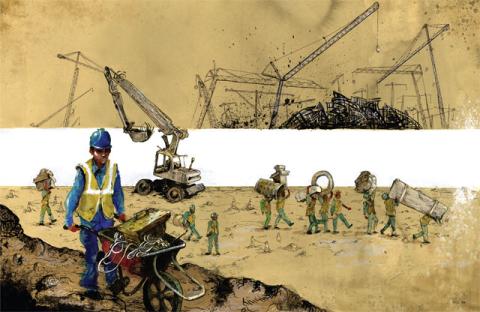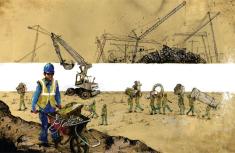Essays on inequality
from art world writers in 2014
Ben Davis, "No, Artists Aren't the Winners of the New Gilded Age," artnet News (online), Wednesday, May 14, 2014
Davis writes "... it's worth really demystifying what a contemporary artist actually does with his or her life, and talking about a fact that everyone knows but is easy to forget amid the party coverage, which only ever presents people at their blandly smiling professional best: Hardly anyone is an “artist" in the sense that they make their living off of their artwork. The idea of being an “artist" is something people identify with aspirationally, while actually working at a day job (or, alternatively, living off of a trust fund). Consequently, if we focus only on artists as artists, we can't actually know how inequality has affected artists as people." And I would have to agree with his concluding remarks when he says "In the end, tackling inequality and injustice within the art world has to be connected to supporting the fight against inequality and injustice outside of it as well. This may seem like a distraction, but I actually think it's part of what might save the art scene from its own irrelevance."
Holland Cotter, “Lost in the Gallery-Industrial Complex," New York Times, January 17, 2014
In his angsty NY-centred state-of-the-scene piece, Cotter writes about money: "Money — the grotesque amounts spent, the inequitable distribution — has dominated talk about art in the 21st century so far. It’s a basic fact of art history. Emperors, popes and robber barons set the model for the billionaire buyers of today. Of course, it is today that matters to the thousands of artists who live and work in this punitively expensive city, where the art industry is often confused with the art world."
W.A.G.E. (WORKING ARTISTS AND THE GREATER ECONOMY) lays down their bullet-pointed manifesto for change, calling for a new social contract between art institutions and artists.
Eunsong Kim and Maya Isabella Mackrandilal, "The Whitney Biennial for Angry Women," The New Inquiry, April 4, 2014
Reviewing the Whitney Biennial the writers take on the show's rhetoric of diversity and expose the pernicious and persistent ethnic and racial inequalities at the heart of the art establishment. A sample of their incisive manifesto-like essay: "Dear White Curators,
1. Diversity is not the inclusion of those not from New York. Diversity isn’t more white women. Diversity isn’t safe art. Diversity isn’t black bodies put on display by white artists....
3. Your theory is tired, your reasoning bland and your politics telling. To use Sara Ahmed’s term, your Biennial is a case study in “reproductive whiteness” – citation practices that privilege whiteness, white thinkers and white history to perpetuate whiteness. We know how to read between the lines.
4. Your choice to reproduce a whitewashed art world has material effects on the lived experiences of people of color and denies the shifts taking place in our visual world.
Jamilla King, "The Overwhelming Whiteness of Black Art," Colorlines, May 21, 2014
In her piece about Kara Walker's A Subtlety, King ponders the inequalities of the demographics of audience: "You’ll smell the molasses as you walk through the exhibit anchored by a 35-foot tall sphinx made of what the artist has called “blood sugar” and sculpted into the shape of a naked mammy. You’ll also see white people. Lots of white people. This is not a bad thing. In fact, it’s reassuring that so many white people have a vested — or at least passing — interest in consuming art that deals with race. At the same time I found it unsettling to view art by a black artist about racism in an audience that’s mostly white. It reinforced the idea that black people’s histories are best viewed but not physically experienced."
Molly Crabapple, “Slaves of Happiness Island," Vice, August 4, 2014
Crabapple's first-person journalism exposes the labour conditions - infrequent work or inhumanly long hours, low pay and confiscated passports - on the site of the soon-to-be built branches of the Louvre, the Guggenheim Abu Dhabi, and New York University.
Susan Jones, "By paying artists nothing, we risck everything," The Guardian Culture Professionals Network, 19 May 2014
In the UK, pay was one of the key issues for the arts sector in 2014. Writing for The Guardian, arts activist Susan Jones revealed that 63% of artists turn down exhibition offers du to pay; and 71% of artists don’t get a fee for publicly-funded exhibitions. According to research from the Paying Artists Campaign the average annual income for an artist is now just £10,000, which represents a £6,000 drop in real income since 1997. “No one should have to work for free,” she wrote. “Artists, just like teachers, surgeons or plumbers, have every right to expect payment for the work they do.”

